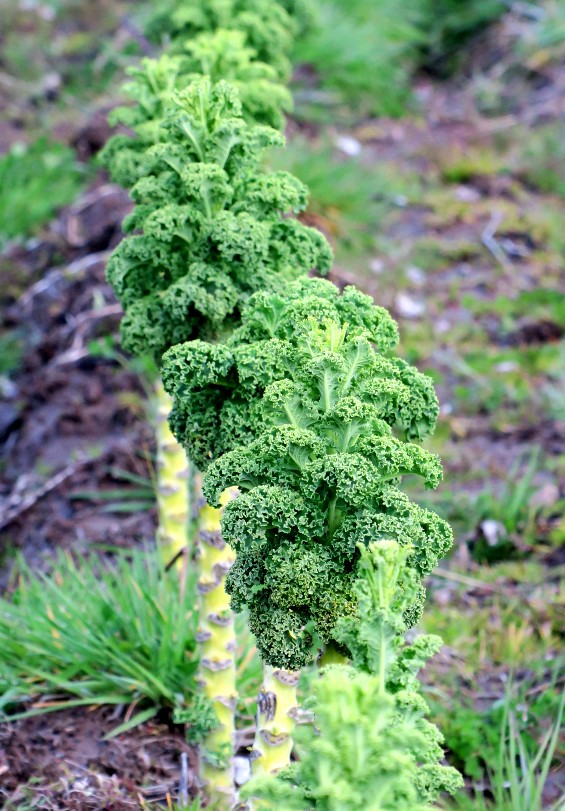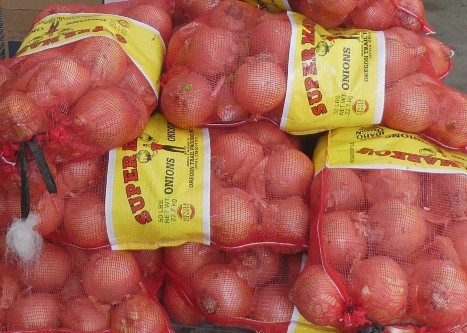Pacific Northwest larders of winter veggies and fruits are close to empty. With the advent of spring and the annual growing season, refilling pantries will begin anew. The thoughts, smells and sounds of spring are everywhere. Migratory birds fly across the skies towards their northern summer homes. Fledglings are hatching. Bird songs fill pre-dawn mornings. Pink rhododendrons pop their blooms. Twelve-inch high garlic sprouts await thinning. The last of the autumn-planted brassicas–kale, broccoli, and chard–sprout flowers to snip to enhance spring meals.
Before global commerce, refrigeration, and mass produced food preservation techniques proliferated, food was scarce from late winter to early spring in temperate climates. Even so, the Pacific Northwest with its maritime climate was blessed with a plethora of over-wintered food possibilities. More so now, eating local through the winter season is easy.
French Onion Soup–Yum!
As a kid, going out to dinner was a rarity. Ordering French onion soup with its long strands of melted cheesy gooeyness perched on a baguette immersed in broth floating with the caramelized onion sweetness was a treat. In olden times, perhaps, it was a mainstay or perhaps even a creation of necessity to craft a meal with the only remaining food ingredients in the cupboard.
French onion soup is the quintessential late winter food with its caramelized onions, flavorful broth, topped with a hunk of crusty bread and smothered with a slice of Swiss Gruyere and a sprinkling of Parmesan cheese. It warms the belly and satisfies. It is a solid, filling food that stokes the fires for the spring chores to start the new agricultural season.
The Onions
To make the soup, yellow keeper onions, overwintered in a root cellar or garage depending on the climate, are slowly sautéed with a little oil to soften and boost the flavors of the onion sugars. By winter, the last of the yellow keeper onions beg to be used before the green sprout emerges from dormancy. Soon the sweet summer varieties like the Walla Walla Sweets will grace the farmers market’s tables.
The Broth
Butcher an old rooster for a special long-cooked Sunday Coq au Vin family meal. Repurpose the carcass and add a beef bone in a water-filled stock pot adding root vegetable trimmings to simmer daylong for the broth. Add dried bay leaf or thyme or both. Sprinkle the broth with minced garlic or perhaps finely chopped spring garlic. Thinning over-wintered garlic, the bulb and green stalk, adds freshness to the soup. Immerse the seasoned onions to the broth.
The Bread
Stonegrind unprocessed wheat kernels for flour. With the bran, the outside sheath of the wheat seed, intact, wheat can be stored through the winter months. Wheat seeds are known to sprout after many years of storage and continue to hold nutritional value. (Even so, in this day and age, it is recommended to freeze and use unground wheat berries within a year, so they don’t become rancid, stale, lose their sprouting ability, or if inappropriately stored, attacked by rodents.) Once ground, make a hearty, crusty bread with primed sourdough starter.
The Cheese
Top the soup with hard cheeses–a slice of Swiss Gruyere hard cheese with a sprinkle of freshly grated Parmesan. In the United States, cheese is typically made from cow, sheep or goat milk produced during the lactation period after an animal gives birth. During pregnancy, female ruminants do not lactate and hence do not produce milk. Soft cheeses–Brie, Camembert, or Muenster–are aged two months or less and are typically available from early spring until Christmas. In the natural cycle, the hard cheeses are aged a minimum of six months or longer. According to the Parmigiano-Reggiano Consortium in Italy, Parmesan must be aged a minimum of 12 months but can be aged for as long as 7 and a half years to generate the premium hard, nutty, sharp flavor expected from an exceptional Parmesan!

Getting Excited for Spring!
Our ancestors in temperate climate cultures, thankfully, had winter storage foods to survive the non-growing months. We continue to celebrate our heritages through the food we eat. The Germans eat sauerkraut, the Koreans savor kimchee, the Swiss delight in many different cheeses, the Japanese augment soups and stir-fry dishes with dried shiitake mushrooms and seaweeds, and the Coast Salish tribes honor and enjoy smoked salmon.
Now with spring upon us we can empty the winter larder, and enjoy our meals with the newness and freshness of spring greens and sprouting brassicas. It’s time to savor and honor the specialties of our food cultures, to connect to our ancestors through the foods we eat, and to anticipate the coming summer specialties.

